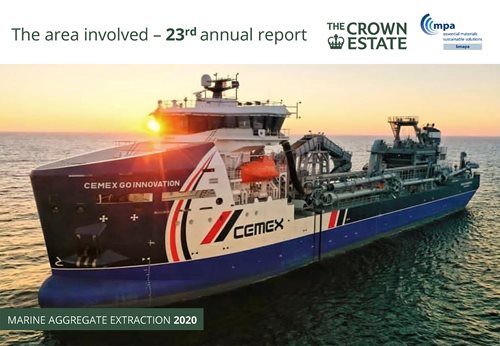 The Crown Estate and The British Marine Aggregate Producers Association (BMAPA) have published their 23rd annual 'Area Involved' report, which details changes in the extent of the seabed area licensed and dredged for marine aggregates during 2020.
The Crown Estate and The British Marine Aggregate Producers Association (BMAPA) have published their 23rd annual 'Area Involved' report, which details changes in the extent of the seabed area licensed and dredged for marine aggregates during 2020.
The 'Area Involved' initiative commenced in March 1999, when BMAPA and The Crown Estate made a public statement of intent which committed both parties to review all dredging licences on a rolling five-year basis, surrendering areas no longer containing economic resources of marine sand and gravel, and publishing an annual report detailing the extent of dredging activities within licensed areas.
Nick Everington, Marine Minerals Portfolio Manager for The Crown Estate, said: “As manager of the seabed around England, Wales and Northern Ireland, we work in partnership with industry to help support the sustainable use of sand and gravel resources. The annual 'Area Involved' report is an integral part of this, providing insight and data to improve our understanding and management of the marine environment over the long term. This 23rd annual report reflects the ongoing commitment from both The Crown Estate and the industry to this important initiative."
Mark Russell, BMAPA Director, said “UK Government has recognised that it is essential there is a sufficient supply of minerals to provide the infrastructure, buildings, energy and goods that our nations need, and marine aggregate supplies play an important role in meeting these needs in England and Wales. The area of seabed licensed and dredged remain key indicators of the UK marine aggregate sector’s performance and its potential to interact with both the environment and other marine users. The significant reductions in both of these over the last two decades reflect an industry committed to continual improvement.”
Key information from the report includes:
- A total of 18 million tonnes of sand and gravel were dredged from Crown Estate licences in England and Wales during 2020 (compared to 22 million tonnes in 2019)
- The total area of seabed licensed in 2020 was 1,055km2 (1,079km2 in 2019)
- Dredging took place within 101 km2, 10 per cent of the licensed area, compared with 105km2 (10 per cent) in 2019
- The area of seabed dredged for more than 1 hour 15 minutes per year (high intensity – red on charts) was 5km2 (6km2 in 2019)
- 90 per cent of dredging effort from Crown Estate licences took place from an area of 42km2 (unchanged since 2019).
Spatial and temporal data relating to the marine aggregate dredging activity have become increasingly important in supporting the sustainable management of UK waters. Both BMAPA and The Crown Estate are committed to maintaining and developing the Area Involved reporting initiative.
Marine aggregates provide over 20% of the sand and gravel demand in England and Wales, with the majority of supply used in high-value ready-mixed concrete and concrete products. Certain regions are particularly reliant upon marine supplies. One-third of all primary aggregate demand in London and the South East of England is met from marine resources, whilst in South Wales over 90% of the market demand for natural sand also comes from the sea.
Ends.
The full report can be accessed here:
https://bmapa.org/documents/23rd-Area-of_Seabed-Dredged-Report-2021.pdf
Notes for Editors:
About BMAPA:
BMAPA is a constituent body of the Mineral Products Association.
About the Mineral Products Association:
The Mineral Products Association (MPA) is the trade association for the aggregates, asphalt, cement, concrete, dimension stone, lime, mortar and silica sand industries. With the merger of British Precast, and affiliation of the British Association of Reinforcement (BAR), Eurobitume, MPA Northern Ireland, MPA Scotland and the British Calcium Carbonate Federation, it has a growing membership of 520 companies and is the sectoral voice for mineral products. MPA membership is made up of the vast majority of independent SME quarrying companies throughout the UK, as well as the 9 major international and global companies. It covers 100% of UK cement and lime production, 90% of GB aggregates production, 95% of asphalt and over 70% of ready-mixed concrete and precast concrete production. In 2018, the industry supplied £16 billion worth of materials and services to the Economy. It is also the largest supplier to the construction industry, which had annual output valued at £172 billion in 2018. Industry production represents the largest materials flow in the UK economy and is also one of the largest manufacturing sectors. www.mineralproducts.org.
For further information, please contact Mark Russell at mark.russell@mineralproducts.org; tel: 07870 596 865.
About The Crown Estate:
- The Crown Estate is a unique business with a distinct heritage and a portfolio of property, rural and marine holdings. In addition to its role in the offshore renewables sector, as manager of the seabed and half the foreshore around England, Wales and Northern Ireland, it also plays a role marine aggregates, cables and pipelines.
- In Central London it holds some of the world’s best places to work, rest and spend time, retail and leisure destinations across the country, and a substantial rural portfolio. It is also responsible for the Windsor Estate, including the world renowned Windsor Great Park
- Its history can be traced back many hundreds of years. In 1961, the Crown Estate Act established it as an independent commercial business and tasked it with returning all profits to the Treasury. Over the last ten years it has generated £2.9 billion for the benefit of the nation’s finances.
For further information please contact: